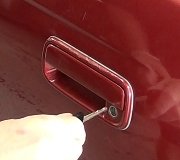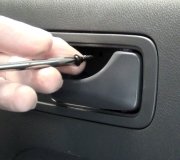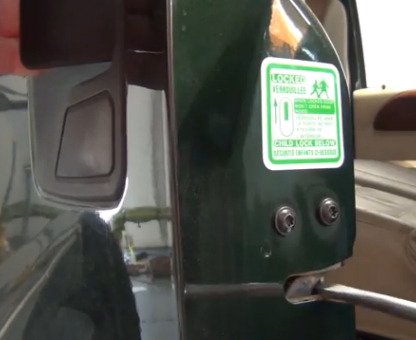Front Door Trim Panel
Removal
Remove interior door handle escutcheon.
Remove cover from door handle escutcheon securing screw and slacken and remove screw.
Pull door handle inwards and exercising care to avoid damaging tweeter, remove escutcheon from casing.
Fig. 49: Removing Interior Door Handle Escutcheon
Remove door casing veneer panel. Refer to FRONT DOOR TRIM PANEL FINISH PANEL.
Slacken and remove the armrest center securing screw.
Fig. 50: Removing Armrest Center Securing Screw
Carefully release the eight fasteners securing lower section of casing to door.
Fig. 51: Releasing Fasteners Securing Lower Section Of Casing To Door
Lift rear edge of door casing to release retaining clip housing from door panel.
Fig. 52: Releasing Retaining Clip Housing From Door Panel
Lift casing clear of door waist flange and lock button and withdraw for access.
Fig. 53: Lifting Casing Clear Of Door Waist Flange And Lock Button
Using pliers, remove housing from clip and fit to door panel.
Disconnect tweeter, speaker, puddle lamp and switchpack harness multiplugs.
Fig. 54: Disconnecting Tweeter, Speaker, Puddle Lamp And Switchpack Harness Multiplugs
Remove armrest lower securing clip housing from casing. And refit to door.
Remove door inner waist seal from holder, slacken and remove screws securing waist seal holder and remove seal holder.
Slacken and remove puddle lamp securing screws and remove lamp assembly from casing.
Release puddle lamp harness from clips at base of door pocket (1).
Slacken and remove the two screws securing bottom of pocket to casing (2).
Remove two spring clips securing top of pocket to casing (3).
Slacken and remove door speaker securing screws and remove speaker from casing.
Door Lock Mechanism
Fig. 1: Identifying Door Lock Mechanism
For most markets, the remote central locking system also, incorporates deadlocking facilities for optimum security. Door locks are eight disc, bayonet fixing barrels with integral lock / unlock switches. Keys include 'in-key' transponders which are programmed to the vehicle via the Jaguar Diagnostic System and operate the engine immobilisation system.
The central locking system employs single key access to the driver's door, trunk lid and ignition switch/steering column lock. An additional green headed valet or parking services key permits access via the driver's door, and ignition/start-up, but denies access to the trunk and glovebox. A valet switch located on the center console switch panel above the radio, precludes normal internal access to the trunk. When the vehicle is not locked, each door catch can be externally released by the corresponding external door handle which operates via a single rod. When unlocked, or 'single action' locked, the door catches can also be released via the interior handles, each of which operates via a single cable. Operation of the front door interior handles will also unlock the rear doors. Use of either key in the external door barrel, operates the lock via a short rod to provide locking of the door latch. These locking functions can also be achieved by use of the remote transmitter. The trunk lid can be independently unlatched via a switch located on the driver's side underscuttle. This will only operate at vehicle speeds up to 8 km/h (5 mph).
All doors and the trunk can be manually locked simultaneously from inside by pressing the driver or front passenger door sill button down. Each rear door can be independently locked by similarly depressing the sill button and in some markets can be released by operating the internal door handle.
For most markets, a 'drive-away door locking' feature automatically locks all doors and the trunk when the gear selector is moved from the Park position
Sunday, January 10th, 2010 AT 7:55 PM



